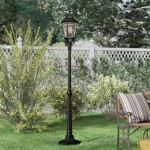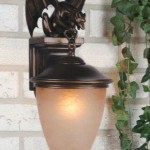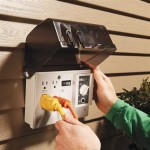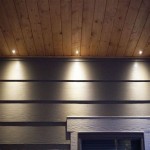Setting Outdoor Motion Sensor Lights
Outdoor motion sensor lights offer a combination of security and convenience, automatically illuminating spaces when movement is detected. Proper installation and configuration are crucial for maximizing their effectiveness and minimizing nuisance activations. This article provides a comprehensive guide to setting up outdoor motion sensor lights effectively.
Choosing the Right Location
The placement of motion sensor lights significantly impacts their performance. Consider the areas you want to illuminate and the range of the sensor. High-traffic areas like walkways, driveways, and entry points are ideal locations. Avoid placing sensors where they might be triggered by moving tree branches, passing cars, or other irrelevant movements. Positioning the sensor too high can reduce its sensitivity to movement below, while positioning it too low may make it susceptible to triggering by small animals.
Understanding Sensor Types
Motion sensors utilize different technologies to detect movement. Passive infrared (PIR) sensors detect changes in heat signatures, making them suitable for most residential applications. Ultrasonic sensors emit ultrasonic waves and detect changes in the reflected waves caused by movement. Dual-technology sensors combine both PIR and ultrasonic technologies for increased accuracy and reduced false triggers. Choosing the appropriate sensor type depends on the specific environment and security needs.
Adjusting Sensitivity and Range
Most motion sensor lights offer adjustable sensitivity and range settings. Sensitivity determines how much movement is required to trigger the light, while range dictates the distance at which the sensor can detect motion. Fine-tuning these settings is critical for optimal performance. Start with the manufacturer's recommended settings and adjust them based on the specific location and desired functionality. Reducing sensitivity can prevent false triggers, while increasing the range can expand the coverage area.
Setting the Lighting Duration
The lighting duration, often referred to as the "time-on" setting, determines how long the light stays on after motion is detected. This setting can usually be adjusted from a few seconds to several minutes. Shorter durations are suitable for areas with frequent movement, while longer durations might be preferable for areas where individuals need more time to pass through, such as driveways or walkways.
Considering Ambient Light Conditions
Many motion sensor lights include a photocell or "daylight sensor" that prevents the light from activating during daylight hours. This feature conserves energy and prolongs the lifespan of the bulb. The sensitivity of the photocell can typically be adjusted to determine the ambient light level at which the sensor becomes active. This setting allows for customization based on individual preferences and the surrounding environment.
Wiring and Installation
Proper wiring is essential for safe and reliable operation. Always follow the manufacturer's instructions for wiring the motion sensor light to the power source. Ensure the power is turned off at the breaker box before beginning any electrical work. Use appropriate wiring gauge and connectors for the voltage and amperage requirements of the light fixture. If unsure about any aspect of the wiring, consult a qualified electrician.
Regular Maintenance and Troubleshooting
Periodic maintenance can help ensure the continued effectiveness of motion sensor lights. Clean the sensor lens regularly to remove dust, dirt, or cobwebs that might interfere with its operation. Check the bulb periodically and replace it as needed. If the light is not functioning correctly, consult the troubleshooting section of the manufacturer’s instructions or seek professional assistance if necessary.
Utilizing Smart Technology Integrations
Modern motion sensor lights often offer integration with smart home platforms. This allows for advanced control and customization through mobile apps or voice assistants. Features such as remote activation, scheduling, and adjustable sensitivity settings can enhance security and convenience. Consider smart technology integration when selecting motion sensor lights to leverage the benefits of automation and remote control.
Selecting the Right Bulb Type
Motion sensor lights are compatible with various bulb types, including incandescent, halogen, CFL, and LED. LED bulbs are generally the most energy-efficient and long-lasting option. Consider the brightness (lumens) and color temperature (Kelvin) when selecting a bulb. Brighter bulbs are better for security purposes, while warmer color temperatures are often preferred for residential applications.

Understanding Motion Lighting

Understanding Motion Lighting

Lightdot Led Security Lights Motion Sensor Light Outdoor 38w 3800lm O

Tips For Setting Up Your Motion Sensor Floodlight

Eti 240 Degree Led Motion Sensor Light Outdoor White 3 Head Flood Security 1800 To 3600 Lumens Driveway Walkway 514032120 The Home Depot

How To Reset A Motion Sensor Light Lighting And Ceiling Fans The Home Depot

Home Zone Security Solar Led Motion Sensor Light Outdoor 6000k 950lm Weatherproof Flood For Garage Porch Yard No Wiring Com

Battery Powered Motion Sensor Led Outdoor Lights Set Of 2 64r86 Lamps Plus

7 Best Outdoor Motion Sensor Lights Of 2024 Tested And Reviewed By Bob Vila

Set Of 2 15 Battery Motion Sensor White Outdoor Wall Lights 64r84 Lamps Plus
Related Posts







